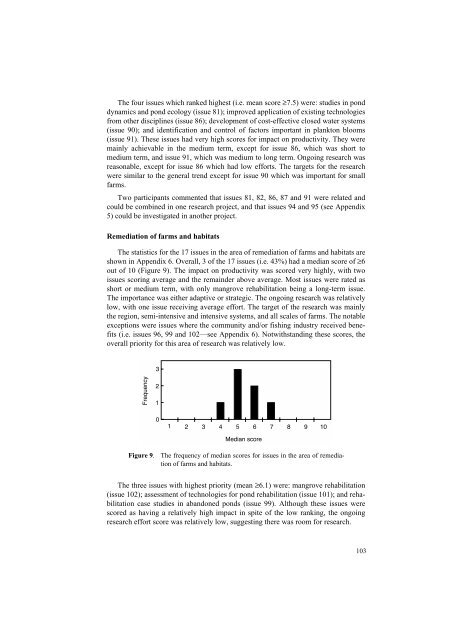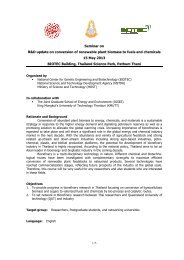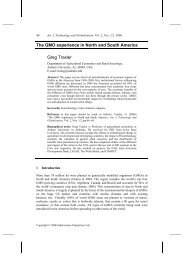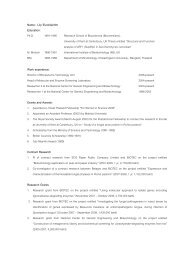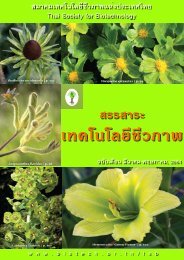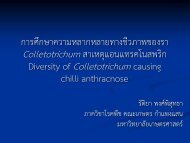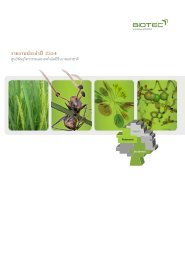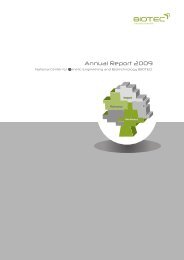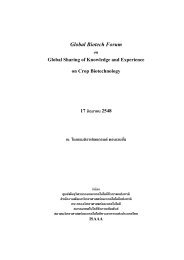Coastal Shrimp Aquaculture in Thailand: Key Issues for Research
Coastal Shrimp Aquaculture in Thailand: Key Issues for Research
Coastal Shrimp Aquaculture in Thailand: Key Issues for Research
Create successful ePaper yourself
Turn your PDF publications into a flip-book with our unique Google optimized e-Paper software.
!! !The four issues which ranked highest (i.e. mean score "7.5) were: studies <strong>in</strong> ponddynamics and pond ecology (issue 81); improved application of exist<strong>in</strong>g technologiesfrom other discipl<strong>in</strong>es (issue 86); development of cost-effective closed water systems(issue 90); and identification and control of factors important <strong>in</strong> plankton blooms(issue 91). These issues had very high scores <strong>for</strong> impact on productivity. They werema<strong>in</strong>ly achievable <strong>in</strong> the medium term, except <strong>for</strong> issue 86, which was short tomedium term, and issue 91, which was medium to long term. Ongo<strong>in</strong>g research wasreasonable, except <strong>for</strong> issue 86 which had low ef<strong>for</strong>ts. The targets <strong>for</strong> the researchwere similar to the general trend except <strong>for</strong> issue 90 which was important <strong>for</strong> smallfarms.Two participants commented that issues 81, 82, 86, 87 and 91 were related andcould be comb<strong>in</strong>ed <strong>in</strong> one research project, and that issues 94 and 95 (see Appendix5) could be <strong>in</strong>vestigated <strong>in</strong> another project.Remediation of farms and habitatsThe statistics <strong>for</strong> the 17 issues <strong>in</strong> the area of remediation of farms and habitats areshown <strong>in</strong> Appendix 6. Overall, 3 of the 17 issues (i.e. 43%) had a median score of "6out of 10 (Figure 9). The impact on productivity was scored very highly, with twoissues scor<strong>in</strong>g average and the rema<strong>in</strong>der above average. Most issues were rated asshort or medium term, with only mangrove rehabilitation be<strong>in</strong>g a long-term issue.The importance was either adaptive or strategic. The ongo<strong>in</strong>g research was relativelylow, with one issue receiv<strong>in</strong>g average ef<strong>for</strong>t. The target of the research was ma<strong>in</strong>lythe region, semi-<strong>in</strong>tensive and <strong>in</strong>tensive systems, and all scales of farms. The notableexceptions were issues where the community and/or fish<strong>in</strong>g <strong>in</strong>dustry received benefits(i.e. issues 96, 99 and 102—see Appendix 6). Notwithstand<strong>in</strong>g these scores, theoverall priority <strong>for</strong> this area of research was relatively low.RA)7X#7',1QGEG Q R S F T U V W GEJ7?*&'!:,0)7Figure 9.The frequency of median scores <strong>for</strong> issues <strong>in</strong> the area of remediationof farms and habitats.The three issues with highest priority (mean "6.1) were: mangrove rehabilitation(issue 102); assessment of technologies <strong>for</strong> pond rehabilitation (issue 101); and rehabilitationcase studies <strong>in</strong> abandoned ponds (issue 99). Although these issues werescored as hav<strong>in</strong>g a relatively high impact <strong>in</strong> spite of the low rank<strong>in</strong>g, the ongo<strong>in</strong>gresearch ef<strong>for</strong>t score was relatively low, suggest<strong>in</strong>g there was room <strong>for</strong> research.103


